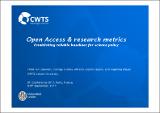Por favor, use este identificador para citar o enlazar a este item:
http://hdl.handle.net/10261/162616COMPARTIR / EXPORTAR:
 SHARE
BASE SHARE
BASE
|
|
| Visualizar otros formatos: MARC | Dublin Core | RDF | ORE | MODS | METS | DIDL | DATACITE | |

| Campo DC | Valor | Lengua/Idioma |
|---|---|---|
| dc.contributor.author | Leeuwen, Thed N. van | es_ES |
| dc.contributor.author | Costas Comesaña, Rodrigo | es_ES |
| dc.contributor.author | Yegros Yegros, Alfredo | es_ES |
| dc.contributor.author | Meijer, Ingeborg | es_ES |
| dc.date.accessioned | 2018-03-21T08:58:33Z | - |
| dc.date.available | 2018-03-21T08:58:33Z | - |
| dc.date.issued | 2017 | - |
| dc.identifier.citation | STI Conference (2017) | es_ES |
| dc.identifier.uri | http://hdl.handle.net/10261/162616 | - |
| dc.description | Trabajo presentado a la Science, Technology and Innovation indicators (STI) Conference, celebrada en Paris (Francia) del 6 al 8 de septiembre de 2017. | es_ES |
| dc.description.abstract | Increasingly, the academic communities are confronted with the demand to publish their findings in an open environment. Science policy and science management has a need for evidence of this change in publishing behavior, which results, as a consequence, in an increasing demand for bibliometric analysis of the shift towards Open Access (OA) publishing. In this study, covering the period 2009-2014, we present the outcomes of the development of OA labels on publications processed for the Web of Science (WoS), and in particular on the in-house version at CWTS. Main reason for this labeling of publications is the need for insight on OA publishing, while the WoS database currently does not serve this purpose well. We have chosen five data sources (DOAJ, ROAD, CrossRef, PubMedCentral, and OpenAIRE), leading to 7 different methods, from which we collect information to attribute OA labels to WoS publications. By using these five sources, we are able to distinguish between Gold and Green OA. Next, we calculated for EU countries the OA shares of the national outputs.; An important conclusion from the study is the increase of OA format publications for EU countries in the period we studies, while the countries with explicit OA mandates, the UK and the Netherlands, have the highest shares of OA output. Another important conclusion is that among the five sources, not one single source we used for attributing OA labels to the WoS publications is enough to cover the OA share among the national output, while it also varies among EU countries which source is most important. | es_ES |
| dc.language.iso | eng | es_ES |
| dc.relation.isversionof | Publisher's version | es_ES |
| dc.rights | openAccess | es_ES |
| dc.title | Open Access & research metrics. Establishing reliable baselines for science policy | es_ES |
| dc.title.alternative | Developing indicators on Open Access by combining evidence from diverse data sources | es_ES |
| dc.type | presentación | es_ES |
| dc.description.peerreviewed | Peer reviewed | es_ES |
| dc.relation.csic | No | es_ES |
| oprm.item.hasRevision | no ko 0 false | * |
| item.openairetype | presentación | - |
| item.grantfulltext | open | - |
| item.cerifentitytype | Publications | - |
| item.openairecristype | http://purl.org/coar/resource_type/c_18cf | - |
| item.fulltext | With Fulltext | - |
| item.languageiso639-1 | en | - |
| Aparece en las colecciones: | (INGENIO) Comunicaciones congresos | |
Ficheros en este ítem:
| Fichero | Descripción | Tamaño | Formato | |
|---|---|---|---|---|
| opemetric.pdf | 692,95 kB | Adobe PDF |  Visualizar/Abrir |
CORE Recommender
Page view(s)
264
checked on 19-abr-2024
Download(s)
106
checked on 19-abr-2024
Google ScholarTM
Check
NOTA: Los ítems de Digital.CSIC están protegidos por copyright, con todos los derechos reservados, a menos que se indique lo contrario.
